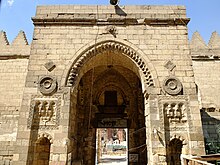This is an old revision of this page, as edited by Yusuf Asar Yathar (talk | contribs) at 09:36, 14 December 2024 (←Created page with ''''Burhān al-Dīn al-Biqāʿī''' (Arabic: برهان الدين البقاعي; died 1480) was a 15th-century Muslim scholar of the Shafi'i school of Islamic thought. He was a prominent critic of the Andalusian philosopher, Ibn Arabi. == Life == Burhan al-Din al-Biqa'i, real name Ibrahim ibn Umar, was born in 1406 in the Beqaa as stated in his epithet al-Biqa'i (from Beqaa).<ref name=":0">{{cite book | last=Saleh | first=W. | title=In De...'). The present address (URL) is a permanent link to this revision, which may differ significantly from the current revision.
Revision as of 09:36, 14 December 2024 by Yusuf Asar Yathar (talk | contribs) (←Created page with ''''Burhān al-Dīn al-Biqāʿī''' (Arabic: برهان الدين البقاعي; died 1480) was a 15th-century Muslim scholar of the Shafi'i school of Islamic thought. He was a prominent critic of the Andalusian philosopher, Ibn Arabi. == Life == Burhan al-Din al-Biqa'i, real name Ibrahim ibn Umar, was born in 1406 in the Beqaa as stated in his epithet al-Biqa'i (from Beqaa).<ref name=":0">{{cite book | last=Saleh | first=W. | title=In De...')(diff) ← Previous revision | Latest revision (diff) | Newer revision → (diff)Burhān al-Dīn al-Biqāʿī (Arabic: برهان الدين البقاعي; died 1480) was a 15th-century Muslim scholar of the Shafi'i school of Islamic thought. He was a prominent critic of the Andalusian philosopher, Ibn Arabi.
Life
Burhan al-Din al-Biqa'i, real name Ibrahim ibn Umar, was born in 1406 in the Beqaa as stated in his epithet al-Biqa'i (from Beqaa). He moved to Damascus and Cairo for his studies. In Cairo, he was a student of Ibn Hajar al-Asqalani. Through Ibn Hajar's recommendation, the ruling Burji Mamluk sultan, Sayf al-Din Jaqmaq accepted al-Biqa'i as a personal tutor. He was also promoted to a role as a teacher at the Mosque of al-Zahir Baybars in Cairo.

During his time in Cairo, he faced harsh criticism from contemporary scholars for his approach to Quranic exegesis. Some of the scholars ordered violent uprisings against him, so he quickly moved back to Damascus for his safety. One of the qadi (Islamic judges) of the Shari'a courts even ruled that al-Biqa'i was an apostate and heretic, but later retracted the ruling.
Burhan al-Din al-Biqa'i died in 1480 and was buried in the cemetery at Bab al-Saghir.
Views
Ibn Arabi
Burhan al-Din al-Biqa'i was very critical of Ibn Arabi and his ideas. He wrote a treatise titled Tanbih al-Ghabi ila Takfir Ibn 'Arabi (The Warning To An Ignorant Regarding Ibn Arabi's Apostasy). The book listed down several of Ibn Arabi's sayings which he considered as blasphemous. He also quoted evidences from other scholars contemporary to and before him, like Zain al-Din al-'Iraqi, to support his evidence that Ibn Arabi was a disbeliever.
Contemporary Muslim scholar, Jalal al-Din al-Suyuti wrote a booklet, Tanbih al-Ghabi bi-Tabri'at Ibn 'Arabi as a refutation of the book and a defence of Ibn Arabi in general.
Quranic exegesis
In his tafsir (commentary of the Qur'an) titled Nazm al-Durar fi Tanasub al-Ayat wa-al-Suwar, he drew extensively on the Hebrew Bible and the New Testament as sources to elucidate certain Qur'anic verses. Aside from this, al-Biqa'i favoured the use of rhetorical and logical coherence as primary tools for interpretation of the Qur'an.
Works
- Nazm al-Durar fi Tanasub al-Ayat wa-al-Suwar: His commentary on the Qur'an.
- Tanbih al-Ghabi bi-Tabri'at Ibn 'Arabi: A criticism of Ibn Arabi and Ibn al-Farid.
See also
References
- ^ Saleh, W. (2008a). In Defense of the Bible: A Critical Edition and an Introduction to al-Biqāʿī's Bible Treatise. Islamic History and Civilization. Brill. ISBN 978-90-474-3378-1.
- ^ "Burhān al-Dīn al-Biqāʿī: A Controversial Man – Mamlukisation of the Mamluk Sultanate II". Retrieved 2024-12-14.
- ^ "منهج العلامة البقاعي في كتاب «النُّكَت الوفيّة بما في شرح الألفية»". web.archive.org. 2011-01-20. Retrieved 2024-12-14.
- Roger Allen; D. S. Richards, eds. (2006). Arabic Literature in the Post-Classical Period. Cambridge University Press. p. 128. ISBN 9780521771603.
- Antonella Ghersetti, ed. (2016). Al-Suyuti, a Polymath of the Mamluk Period. Islamic History and Civilization. Vol. 138. Brill. p. 11. ISBN 9789004334526.
- al-Biqa'i, ed. (2013). Tanbih al-Ghabi ila Takfir Ibn 'Arabi. Turath Publishing. ISBN 9957635212.
- Ibn Khafif (1999). Correct Islamic Doctrine/Islamic Doctrine. Translated by Gibril Fouad Haddad. Islamic Supreme Council of America. pp. 6–7. ISBN 9781930409019.